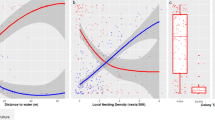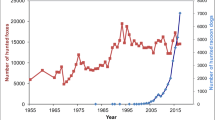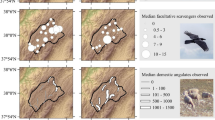Abstract
Supplementing vulture populations with carcasses disposed at feeding stations is a common management and conservation practice worldwide. However, there is a lack of knowledge on the dependence of large vultures on the supplementary feeding stations (SFS) in areas with high abundance of natural food. We tagged 11 Griffon Vultures (Gyps fulvus, Hablizl 1783) with GSM/GPS transmitters in the Eastern Rhodopes, Bulgaria and studied the seasonal dynamic of feedings at SFS and at occasional carcasses found in the field. We used combination of remote sensing and field inspections to identify the vulture feeding events. Our results show that most of the feeding events occurred at occasional carcasses found in the wild (77.4%), whereas only 22.6% were at SFS, but high seasonal variation was observed. Vulture’s reliance on feeding stations was lowest in summer (19.82 ± 7.8%) and highest in winter when 56.5 ± 16.1% of the feedings were at the SFS. Griffon Vultures travelled longer daily distances in days feeding in the wild compared to days when they were not feeding or were visiting SFS. Our study indicates that in habitats with high abundance of natural food (free-range livestock and game), vultures tend to actively forage and use feeding stations as supplemental sources of food, mostly during long periods of adverse weather or in winter when foraging conditions are worse and natural food is less abundant.
Zusammenfassung
Saisonale Dynamik bei der Nutzung natürlicher Kadaver und zusätzlicher Futterstellen durch eine aasfressende Vogelart
Eine ergänzende Versorgung von Geierpopulationen mit Kadavern, die an Futterstellen ausgelegt werden, ist weltweit ein typisches Management- und Naturschutzverfahren. Jedoch ist noch unbekannt, inwieweit große Geierarten auf diese zusätzlichen Futterstellen (engl. supplementary feeding stations, SFS) in Gebieten mit hohem natürlichen Nahrungsangebot angewiesen sind. Wir markierten elf Gänsegeier (Gyps fulvus, Hablizl 1783) mit GSM/GPS-Sendern in den östlichen Rhodopen, Bulgarien, und untersuchten die saisonale Dynamik der Fütterungen an SFS sowie an gelegentlich im Feld gefundenen Kadavern. Wir verwendeten eine Kombination aus Fernerkundung und Feldbegehungen, um die Fressereignisse der Geier zu erfassen. Unsere Ergebnisse zeigen, dass die meisten Fressereignisse an gelegentlich in der freien Natur gefundenen Kadavern stattfanden (77.4 %), während nur 22.6 % an SFS erfolgten, wobei jedoch starke saisonale Schwankungen beobachtet wurden. Die Abhängigkeit der Geier von den SFS war im Sommer mit 19.8 ± 7,8 % am geringsten und im Winter am höchsten, wo 56.5 ± 16.1 % der Fressereignisse an den SFS stattfanden. Gänsegeier legten an Tagen, an denen sie in der freien Natur gefressen haben, längere Tagesstrecken und weniger Direktflüge zurück als an Tagen, an denen sie gar nicht fraßen oder SFS aufsuchten. Unsere Studie lässt darauf schließen, dass Geier in Habitaten mit einem hohen natürlichen Nahrungsangebot (freilaufendes Vieh und Wild) dazu tendieren, aktiv auf Nahrungssuche zu gehen und SFS als ergänzende Nahrungsquelle zu nutzen, vor allem während langer Schlechtwetterperioden oder im Winter, wenn die Nahrungssuchbedingungen schlechter werden und das natürliche Nahrungsangebot abnimmt.





Similar content being viewed by others
Data availability
The datasets generated during and/or analysed during the current study are available from the corresponding author on reasonable request.
Code availability
Not applicable.
References
Arkumarev V, Dobrev D, Stamenov A, Terziev N, Delchev A, Stoychev S (2021) Using GPS and ACC data to study diet of a top avian scavenger. Bird Study. https://doi.org/10.1080/00063657.2020.1864285
Arrondo E, Moleón M, Cortés-Avizanda A, Jiménez J, Beja P, Sánchez-Zapata JA, Donázar JA (2018) Invisible barriers: differential sanitary regulations constrain vulture movements across country borders. Biol Conserv 219:46–52. https://doi.org/10.1016/j.biocon.2017.12.039
Azmanis PN (2009) Regulations of transmissible spongiform encephalopathies (TSEs) and management of feeding sites for birds of prey: a comparative approach between Western Europe (Iberian Peninsula and France) and the Balkan Peninsula. In: Donazar JA, Margalida A, Campion D (eds) Buitres, muladares y legislation sanitaria: perspectives de un conflicto y sus consecuencias desde la biologia de la conservation. Aranzadi, Donostia, Spain, pp 521–525
Bodey TW, Cleasby IR, Bell F, Parr N, Schultz A, Votier SC et al (2018) A phylogenetically controlled meta-analysis of biologging device effects on birds: deleterious effects and a call for more standardized reporting of study data. Methods Ecol Evol 9:946–955. https://doi.org/10.1111/2041-210X.12934
Bose M, Duriez O, Sarrazin F (2012) Intra-specific competition in foraging griffon vultures: 1. The dynamics of feeding in groups. Bird Study 59:182–192
Camina A (2004) Consequences of Bovine Spongiform Encephalopathy (BSE) on breeding success and food availability in Spanish Vulture populations. In: Chancellor RD, Meyburg BU (eds) Sixth world conference on birds of prey and owls. Budapest, Hungary, pp 27–44
Carrete M, Donazar JA, Margalida A (2006) Density-dependent productivity depression in Pyrenean Bearded Vultures: implications for conservation. Ecol Appl 16:1674–1682
Corlett RT (2016) The role of rewilding in landscape design for conservation. Curr Landsc Ecol Rep 1(3):127–133
Cortés-Avizanda A, Jovani R, Carrete M, Donazar JA (2013) Resource unpredictability promotes species diversity and coexistence in an avian scavenger guild: a field experiment. Ecology 93:2570–2579
Cramp S, Simmons K (1980) The birds of the Western Palearctic, vol 2. Oxford University Press, London
Damyanov D, Genov P (2019) Dynamics of the number and shooting of wild boar (Sus scrofa L.) in Bulgaria and the danger of epizootic. Third international conference on zoology, zoonoses and epidemiology. 21–23 October 2019, Hissar, Bulgaria. Book of abstracts, pp 143–144
Demerdzhiev D, Hristov H, Dobrev D, Angelov I, Kurtev M (2014) Long-term population status, breeding parameters and limiting factors of the Griffon Vulture (Gyps fulvus) population in Eastern Rhodopes. Bulg Acta Zool Bulg 66(3):373–384
Deygout C, Gault A, Duriez O, Sarrazin F, Bessa-Gomes C (2010) Impact of food predictability on social facilitation by foraging scavengers. Behav Ecol 21:1131–1139
Dobrev D, Arkumarev V, Skartsi T, Stamenov A, Kret E (2019) Griffon Vulture population trend and size in the Eastern Rhodopes at the crossroads to Asia. Poster, European vulture conference, Algarve, Portugal 1–4 October 2019
Dobrev DD, Delchev AG, Stamenov AA, Arkumarev VA (2020) Individually marked Eurasian Griffon Vulture (Gyps fulvus) occurrence phenology in the Eastern Rhodopes. Bulg Ecol Balk 2(2):31–41
Donazar JA, Margalida A, Carrete M, Sanchez-Zapata JA (2009b) Too sanitary for vultures. Science 326:664
Donazar JA, Margalida A, Campion D (2009a) Vultures, Feeding stations and sanitary legislation: a conflict and its consequences from the perspective of conservation biology. Munibe, vol 29 (suppl). Sociedad de Ciencias Aranzadi, Donostia
Douglas B, Maechler M, Bolker B, Walker S (2015) Fitting linear mixed-effects models using lme4. J Stat Softw 67(1):1–48. https://doi.org/10.18637/jss.v067.i01
Duriez O, Herman S, Sarrazin F (2012) Intra-specific competition in foraging griffon vultures: 2. the influence of supplementary feeding management. Bird Study 59:193–206
Duriez O, Kato A, Tromp C, Dell’Omo G, Vyssotski AL, Sarrazin F, Ropert-Coudert Y (2014) How cheap is soaring flight in raptors? A preliminary investigation in freely-flying vultures. PLoS ONE 9:e84887. https://doi.org/10.1371/journal.pone.0084887
Fergusson-Lees J, Christie D (2001) Raptors of the world. Christopher Helm, London
Fluhr J, Benhamou S, Riotte-Lambert L, Duriez O (2017) Assessing the risk for an obligate scavenger to be dependent on predictable feeding sources. Biol Conserv 215:92–98
Forsman D (2003) The Raptors of Europe and the Middle East. A handbook of field identification. T & A D Poyser, London
Gilbert M, Watson RT, Ahmed S, Asim M, Johnson JA (2007) Vulture restaurants and their role in reducing diclofenac exposure in Asian vultures. Bird Conserv Int 17:63–77
Gonzalez LM, Margalida A, Sanchez R, Oria J (2006) Supplementary feeding as an effective tool for improving breeding success in the Spanish imperial eagle (Aquila adalberti). Biol Conserv 129:477–486
Grilli MG, Bildstein KL, Lambertucci SA (2019) Nature’s clean-up crew: Quantifying ecosystem services offered by a migratory avian scavenger on a continental scale. Ecosyst Serv 39:100990. https://doi.org/10.1016/j.ecoser.2019.100990
Grubač B (2013) Vulture status and conservation in Serbia. In: Andevski J (ed) Vulture Conservation in the Balkan Peninsula and Adjacent Regions. 10 Years of Vulture Research and Conservation, Skopje, pp 30–33
Grubač B (2014) The Griffon vulture Gyps fulvus. Nature Conservation Institute, Serbia, p 256
Harel R, Duriez O, Spiegel O, Fluhr J, Horvits N, Getz WM, Bouten W, Sarrazin F, Hatzofe O, Nathan R (2016) Decision-making by a soaring bird: time, energy and risk considerations at different spatio-temporal scales. Philos Trans R Soc. https://doi.org/10.1098/rstb.2015.0397
Harel R, Spiegel O, Getz WM, Nathan R (2017) Social foraging and individual consistency in following behaviour: testing the information Centre hypothesis in free-ranging vultures. Proc R Soc B 284:20162654. https://doi.org/10.1098/rspb.2016.2654
Houston DC (1989) Factors influencing the timing of breeding in African vultures. In: Meyburg B-U, Chancellor RD (eds) Raptors in the modern world. WWGBP, Berlin, pp 203–210
Kane A, Wolter K, Neser W, Kotze A, Naidoo V, Monadjem A (2016) Home range and habitat selection of cape vultures Gyps coprotheres in relation to supplementary feeding. Bird Study 63:387–394
Kopralev I (2002) Geography of Bulgaria. In: Physical and socio-economic geography, Sofia (ForKom), pp 760 (in Bulgarian)
Kozelov L, Toneva M, Ignatova M, Petkova M, Nanev N, Yossifov M (2012) State and outlook of the Bulgarian animal production after the accession of Bulgaria to the EU. Biotechnology in animal husbandry 28(2):155–166
Lieury N, Gallardo M, Ponchon C, Besnard A, Millon A (2015) Relative contribution of local demography and immigration in the recovery of a geographically-isolated population of the endangered Egyptian vulture. Biol Conserv 191:349–356
Margalida A, Colomer MA (2012) Modelling the effects of sanitary policies on European vulture conservation. Sci Rep 2:753
Margalida A, Donázar JA, Carrete M, Sánchez-Zapata JA (2010) Sanitary versus environmental policies: fitting together two pieces of the puzzle of European vulture conservation. J Appl Ecol 47:931–935
Markandya A, Taylor T, Longo A, Murty MN, Murty S, Dhavala K (2008) Counting the cost of vulture decline—an appraisal of the human health and other benefits of vultures in India. Ecol Econ 67:194–204
Mateo-Tomas P (2009) Conservation and management of vultures in the Cantabrian mountains. Dissertation, University of León, Spain
Mateo-Tomas P, Olea PP, Sánchez-Barbudo IS, Mateo R (2012) Alleviating human-wildlife conflicts: identifying the causes and mapping the risk of illegal poisoning of wild fauna. J Appl Ecol 49:376–385
Mateo-Tomas P, Olea P, Lopez-Bao JV, Gonzalez-Quiros P, Peon P (2018) Different criteria for implementing sanitary regulations leads to disparate outcomes for scavenger conservation. J Appl Ecol. https://doi.org/10.1111/1365-2664.13293
Mendelssohn H, Leshem Y (1983) Observations on reproduction and growth of Old World vultures. In: Wilbur SR, Jackson JA (eds) Vulture biology and management. University of California Press, Los Angeles, pp 214–241
Monsarrat S, Benhamou S, Sarrazin F, Bessa-Gomes C, Bouten W, Duriez O (2013) How predictability of feeding patches affects home range and foraging habitat selection in avian social scavengers? PLoS ONE 8:e53077
Morales-Reyes Z, Pérez-García JM, Moleón M, Botella F, Carrete M, Donázar JA, Cortés-Avizanda A, Arrondo E, Moreno-Opo R, Margalida A (2017) Evaluation of the network of protection areas for the feeding of scavengers in Spain: from biodiversity conservation to greenhouse gas emission savings. J Appl Ecol 54:1120–1129
Nathan R, Spiegel O, Fortmann-Roe S, Harel R, Wikelski M, Getz WM (2012) Using tri-axial acceleration data to identify behavioral modes of free-ranging animals: general concepts and tools illustrated for griffon vultures. J Exp Biol 215:986–996
Navarro LM, Pereira HM (2012) Rewilding abandoned landscapes in Europe. Ecosystems 15:900–912
Ntemiri K, Saravia V, Angelidis C, Baxevani K, Probonas M, Kret E, Mertzanis Y, Iliopoulos Y, Georgiadis L, Skartsi D (2018) Animal mortality and illegal poison bait use in Greece. Environ Monit Assess. https://doi.org/10.1007/s10661-018-6838-5
Olea PP, Mateo-Tomás P (2009) The role of traditional farming practices in ecosystem conservation: The case of transhumance and vultures. Biol Conserv 142:1844–1853
Oro D, Margalida A, Carrete M, Heredia R, Donázar JA (2008) Testing the goodness of supplementary feeding to enhance population viability of an endangered vulture. PLoS ONE 3:e4084
Pain DJ, Cunningham AA, Donald PF, Dukworth JW, Houston DC, Katzner T, Parry-Jones J, Poole C, Prakash V, Round P, Timmins R (2003) Causes and effects of temporal and spatial declines of Gyps vultures in Asia. Conserv Biol 17:661–671
Pantovic U, Andevski J (2018) Review of the problem of poison use and vulture poisoning in the Balkan Peninsula. Vulture Conservation Foundation, Netherlands, p 72
QGIS Development Team (2015) QGIS geographic information system. Open Source Geospatial Foundation Project. http://qgis.osgeo.org
R Core Team (2018) R: A language and environment for statistical computing. R Foundation for Statistical Computing, Vienna, Austria. https://www.R-project.org/.
Rangelova R, Vladimirova K (2017) Agricultural sector in Bulgaria during the transition to market economy and the integration into the European Union. Agric Res Econ 3(2):30–43
Resheff YS, Rotics S, Harel R, Spiegel O, Nathan R (2014) AcceleRater: a web application for supervised learning of behavioral modes from acceleration measurements. Mov Ecol 2:27
Ruxton GD, Houston DC (2004) Obligate vertebrate scavengers must be large soaring fliers. J Theor Biol 228:431–436
Santangeli A, Spriegel O, Bridgeford P, Girardello G (2018) Synergistic effect of land-use and vegetation greenness on vulture nestling body condition in arid ecosystems. Sci Rep 8:13027. https://doi.org/10.1038/s41598-018-31344-2
Shapiro S, Wilk M, Chen H (1968) A comparative study of various tests of normality. J Am Stat Assoc 63:1343–1372
Spiegel O, Harel R, Getz WM, Nathan R (2013) Mixed strategies of griffon vultures’ (Gyps fulvus) response to food deprivation lead to a hump-shaped movement pattern. Mov Ecol 1:5. https://doi.org/10.1186/2051-3933-1-5
Statsoft (2010) STATISTICA (data analysis software system), version 10. www.statsoft.com.
Stoynov E, Kmetova-Biro E, Stoyanov G, Peshev H, Ivanov I, Stoev I, Bonchev L, Vangelova N, Nikolova Z, Iankov L, Parvanov D, Grozdanov A (2018) Population Boost of the Griffon Vulture (Gyps fulvus Hablizl, 1783) (Accipitride) in Bulgaria based on reintroductions. Acta Zool Bulg Suppl 12:59–65
Sušić G, Radek V (2013) Vulture status and conservation in Croatia. In: Andevski J (ed) Vulture conservation in the Balkan Peninsula and adjacent regions. 10 years of vulture research and conservation, Skopje, pp 16–19
Tella JL (2001) Action is needed now, or BSE crisis could wipe out endangered birds of prey. Nature 410:408
Terrasse M, Sarrazin F, Choisy JP, Clemente C, Henriquet S et al (2004) A success story: the reintroduction of Eurasian griffon Gyps fulvus and Black Aegypius monachus vultures in France. In: Chancellor RD, Meyburg B-U (eds) Raptors Worldwide. Budapest, WWGBP/MME, pp 127–145
Velevski M, Lisitchanets E, Lisitchanets T (2013) Vulture status and conservation in Macedonia. In: Andevski J (ed) Vulture Conservation in the Balkan Peninsula and Adjacent Regions. 10 Years of Vulture Research and Conservation. Skopje, pp 26–29
Virani MZ, Kendall C, Njoroge P, Thomsett S (2011) Major declines in the abundance of vultures and other scavenging raptors in and around the Masai Mara ecosystem, Kenya. Biol Cons 144:746–752
Walter WD, Fischer JW, Baruch-Mordo S, VerCauteren KC (2011) What is the proper method to delineate home range of an animal using today’s advanced GPS telemetry systems: the initial step. In: Krejcar O (ed) Modern telemetry. In Tech Open Access Publisher, Rijeka, pp 249–268
Xirouchakis SM, Andreou G (2009) Foraging behavior and flight characteristics of Griffon Vultures (Gyps fulvus) in the island of Crete (Greece). Wildlife Biology 15:37–52
Xirouchakis SM, Mylonas M (2007) Breeding behavior and parental care in the Griffon Vulture Gyps fulvus on the island of Crete (Greece). Ehol Ecol Evol 19:1–26
Xirouchakis S, Tsiakiris R (2009) Status and population trends of vultures in Greece. In: Donázar JA, Margalida A, Cambion A (eds) Vultures, feeding stations and sanitary legislations: a conflict and its consequences from the perspective of conservation biology. Donostia, Aranzadi, pp 154–171
Zeileis A, Hothorn T (2002) Diagnostic checking in regression relationships. R News 2(3):7–10. https://CRAN.R-project.org/doc/Rnews/
Acknowledgements
This research was financed by the National program "Young scientists and Postdoctoral candidates" funded by the Bulgarian Ministry of Education and Science. The fieldwork and data collection were conducted in the frame of the LIFE project “Conservation of Black and Griffon Vultures in the cross-border Rhodope Mountains” (LIFE14 NAT/NL/000901) funded by the European Union and supported by Rewilding Europe, Segre Foundation and WWF-Greece. We would like to express our gratitude to Hristo Hristov, Desislava Kostadinova, Vera Alekseeva, Stefan Avramov and Connor Panter for assisting in the fieldwork and to the Management body of Dadia-Soufli-Lefkimi Forest National Park, Marin Kurtev and Georgi Sheremetev for providing data on the number of supplementary feedings conducted at the SFS in the Eastern Rhodopes. We are grateful to Dimitar Demerdzhiev and two anonymous reviewers for providing helpful comments on preliminary versions of the paper and to Lavrentis Sidiropoulos for assisting in the statistical analyses.
Funding
This study was financed by the National program "Young scientists and Postdoctoral candidates" funded by the Bulgarian Ministry of Education and Science. The fieldwork and data collection were conducted in the frame of the LIFE project “Conservation of Black and Griffon Vultures in the cross-border Rhodope Mountains” (LIFE14 NAT/NL/000901) funded by the European Union and supported by Rewilding Europe, Segre Foundation and WWF-Greece.
Author information
Authors and Affiliations
Corresponding author
Ethics declarations
Conflict of interest
The authors declare that they have no conflict of interest.
Ethics approval
The trapping and tagging of Griffon Vultures were permitted by the Ministry of Environment and Waters of the Republic of Bulgaria (Permission No 675/14.04.2016, 710/25.05.2017).
Additional information
Communicated by O. Krüger.
Publisher's Note
Springer Nature remains neutral with regard to jurisdictional claims in published maps and institutional affiliations.
Rights and permissions
About this article
Cite this article
Arkumarev, V., Dobrev, D., Stamenov, A. et al. Seasonal dynamics in the exploitation of natural carcasses and supplementary feeding stations by a top avian scavenger. J Ornithol 162, 723–735 (2021). https://doi.org/10.1007/s10336-021-01865-1
Received:
Revised:
Accepted:
Published:
Issue Date:
DOI: https://doi.org/10.1007/s10336-021-01865-1




